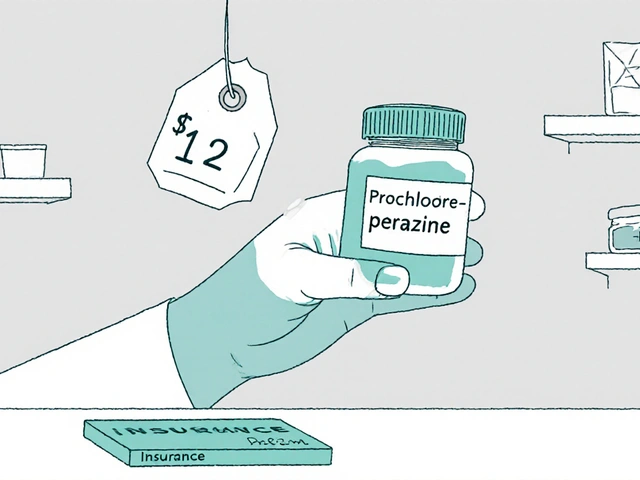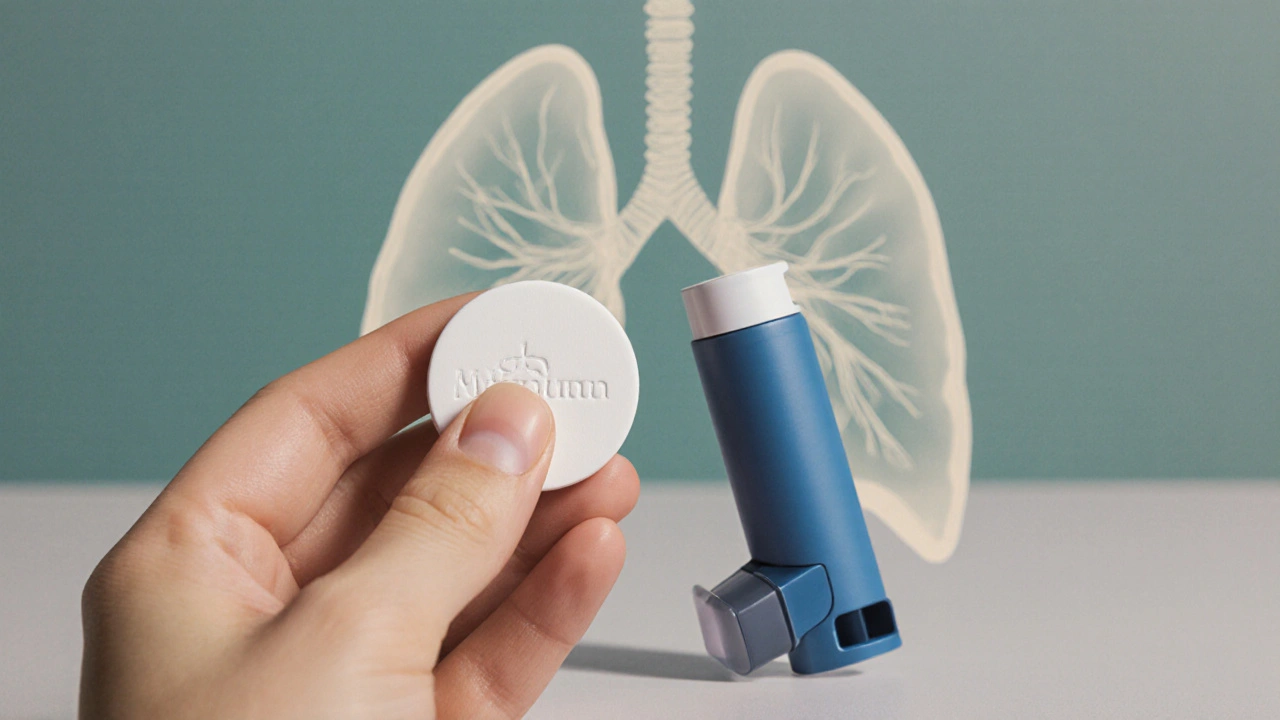Quibron-T vs. Other Asthma & COPD Treatments
Form: Tablet
Onset: 30-60 minutes
Duration: 8-12 hours
Side Effects: Nausea Insomnia Tachycardia
Use Case: Maintenance for asthma/COPD when inhalers aren't enough
Form: Inhaler
Onset: 5-10 minutes
Duration: 4-6 hours
Side Effects: Tremor Jitteriness
Use Case: Quick-relief rescue
Form: Inhaler
Onset: 15-30 minutes
Duration: 6-8 hours
Side Effects: Dry mouth Cough
Use Case: Adjunct for COPD or stable asthma
Form: Tablet
Onset: 60-120 minutes
Duration: 24 hours
Side Effects: Mood changes Headache
Use Case: Allergy-driven asthma, exercise-induced
Form: Inhaler
Onset: 5-15 minutes
Duration: 12-24 hours
Side Effects: Hoarseness Oral thrush
Use Case: Long-term inflammation control
Form: Pill
Onset: 30-60 minutes
Duration: Variable (short courses)
Side Effects: Weight gain Mood swings
Use Case: Severe exacerbations
Recommended Treatment Based on Your Profile
Your profile suggests Quibron-T could be effective for maintaining daily control if you struggle with inhaler technique or need a once-daily oral option.
However, for immediate relief during asthma attacks, consider pairing it with a Salbutamol inhaler.
Important: Always consult your doctor before starting or changing medications.
Ever wonder if the little tablet you call Quibron‑T is really the best fit for your breathing problems? You’re not alone. Millions of people with asthma or COPD wrestle with the same question every time they reach for a pill bottle.
What is Quibron‑T?
Quibron‑T is a tablet form of the bronchodilator theophylline used to treat asthma and chronic obstructive pulmonary disease (COPD). The active ingredient, theophylline, belongs to the methylxanthine class - the same family as caffeine. It works by relaxing the smooth muscles around the airways, making it easier to breathe.
How does theophylline actually work?
When you take Quibron‑T, theophylline blocks an enzyme called phosphodiesterase, which raises cyclic AMP levels in airway cells. Higher cyclic AMP forces the muscles to relax and also reduces inflammation. The result? Wider air passages and fewer coughing fits.
Who typically uses Quibron‑T?
The drug is most often prescribed for:
- Patients with persistent asthma who still experience symptoms despite inhaled steroids.
- People with moderate to severe COPD who need an oral bronchodilator.
- Those who prefer a once‑daily tablet over multiple inhalations.
Because theophylline has a narrow therapeutic window, doctors monitor blood levels regularly to avoid toxicity.
Top Alternatives to Quibron‑T
If you’re hunting for other options, here’s a quick rundown of the most common substitutes. Each one tackles breathing problems a bit differently, so the best choice depends on your specific needs.
- Salbutamol - a short‑acting beta‑2 agonist (SABA) inhaled for rapid relief of wheeze.
- Ipratropium - an anticholinergic inhaler that blocks bronchoconstriction, often combined with albuterol.
- Montelukast - a leukotriene receptor antagonist taken orally, useful for asthma triggered by allergies.
- Budesonide - an inhaled corticosteroid that reduces airway inflammation over the long term.
- Oral corticosteroids - a short burst of prednisone‑type drugs for severe flare‑ups.

Side‑Effect Snapshot
Every medication has trade‑offs. Below is a quick side‑effect cheat sheet for Quibron‑T and its main rivals.
- Quibron‑T: nausea, insomnia, rapid heart beat, risk of seizures at high levels.
- Salbutamol: tremor, jitteriness, occasional throat irritation.
- Ipratropium: dry mouth, cough, rare urinary retention.
- Montelukast: mood changes, headache, abdominal pain.
- Budesonide: hoarseness, oral thrush, mild cough.
- Oral corticosteroids: weight gain, mood swings, increased infection risk.
Comparison Table
| Drug | Form | Onset (minutes) | Duration (hours) | Main Side‑Effects | Typical Use‑Case |
|---|---|---|---|---|---|
| Quibron‑T (theophylline) | Tablet | 30-60 | 8-12 | Nausea, insomnia, tachycardia | Maintenance for asthma/COPD when inhalers aren’t enough |
| Salbutamol (albuterol) | Inhaler | 5-10 | 4-6 | Tremor, jitteriness | Quick‑relief rescue |
| Ipratropium | Inhaler | 15-30 | 6-8 | Dry mouth, cough | Adjunct for COPD or asthma‑stable |
| Montelukast | Tablet | 60-120 | 24 | Mood changes, headache | Allergy‑driven asthma, exercise‑induced |
| Budesonide | Inhaler | 5-15 | 12-24 | Oral thrush, hoarseness | Long‑term inflammation control |
| Oral corticosteroids | Pill | 30-60 | Variable (short courses) | Weight gain, mood swings | Severe exacerbations |
How to Choose the Right Option
Pick a medication by asking yourself three simple questions:
- Speed vs. duration: Do you need instant relief (Salbutamol) or a steady, all‑day effect (Quibron‑T, Budesonide)?
- Delivery preference: Do you like a pill you can swallow, or are you comfortable with an inhaler?
- Side‑effect tolerance: Are you okay with potential insomnia, or would you rather risk a dry mouth?
For most people with mild‑to‑moderate asthma, an inhaled steroid plus a rescue inhaler covers the basics. Quibron‑T becomes attractive when inhaler technique is poor, when you need a once‑daily oral option, or when you have COPD where a systemic bronchodilator adds value.
Practical Tips for Using Quibron‑T Safely
- Never skip blood‑level checks - aim for 10‑20µg/mL.
- Take the tablet with food to reduce stomach upset.
- Avoid caffeine‑heavy drinks; they can push theophylline levels higher.
- Inform any new doctors that you’re on a methylxanthine - it interacts with certain antibiotics and anti‑arrhythmics.
- If you notice jitteriness or heart palpitations, call your GP immediately.
Key Takeaways
- Quibron‑T offers a convenient oral route but demands careful monitoring.
- Inhaled options like Salbutamol and Budesonide act faster and have fewer systemic side‑effects.
- Montelukast is a good adjunct for allergy‑driven asthma, not a direct bronchodilator.
- For severe COPD, combining a long‑acting bronchodilator with an anticholinergic (e.g., Ipratropium) often outperforms theophylline alone.

Frequently Asked Questions
Is Quibron‑T safe for long‑term use?
When blood levels stay within the therapeutic window and you avoid high‑caffeine diets, many patients use theophylline for years without major issues. Regular monitoring is the key.
Can I switch from an inhaler to Quibron‑T?
Only under a doctor’s guidance. Theophylline isn’t a rescue drug, so you’ll still need a fast‑acting inhaler for sudden attacks.
What foods should I avoid while on Quibron‑T?
Limit coffee, tea, chocolate, and energy drinks. These contain caffeine, which can raise theophylline levels and increase side‑effects.
How does the cost of Quibron‑T compare to inhalers?
In the UK, a 30‑day supply of Quibron‑T typically costs around £12‑£15, whereas a similar‑strength inhaled steroid can run £20‑£30. However, you may need multiple inhalers, so total expense varies.
Are there any age restrictions for Quibron‑T?
It’s generally prescribed to adults and children over 12years. Pediatric doses are weight‑based and require close monitoring.



